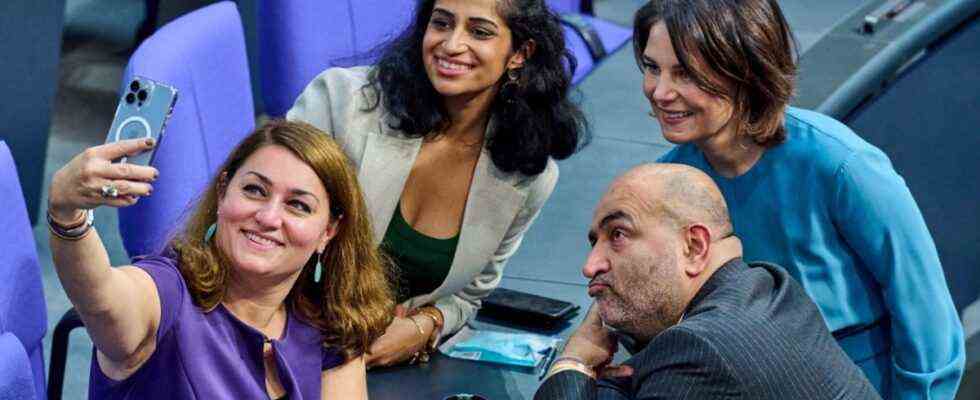So now the moving of chairs begins at the top of the Greens. And as with the trip to Jerusalem, one or the other will soon be thrown out of the circle of the most important players. Because it’s gotten pretty tight now.
Tuesday of this week, constituent session of the Bundestag, the new parliament meets for the first time. It’s a lively rendezvous where old political acquaintances and new rivals greet and sniff each other. As always, before the session begins, there is plenty of cockling and posing, because that’s how you can set signs.
The Bundestag newcomer and Greens leader Robert Habeck, for example, stands right at the front of the plenary with the important and the most important, the presumably next Chancellor Olaf Scholz, the still-Agriculture Minister Julia Klöckner and CDU General Secretary Paul Ziemiak. Green leader Annalena Baerbock is further back, with the youngsters in the parliamentary group and women. And then they take a seat: Habeck next to Baerbock, two Greens chairmen, who are now both members of the Bundestag. Right in front of them: the parliamentary group leaders Katrin Göring-Eckardt and Anton Hofreiter. A green seat and power block has arisen in parliament. And to cut it short: it cannot stay that way.
It’s all routine, don’t panic, says the party
Five members of the Green Party Executive Committee now have a mandate for the Bundestag. In addition to Baerbock and Habeck, the vice-party chairmen Ricarda Lang and Jamila Schäfer also sit in parliament, along with federal manager Michael Kellner. But that is not compatible with the Greens statutes. A maximum of every third member of the six-member federal executive board may have a seat in the Bundestag, i.e. two people. The green party leadership must therefore be rebuilt, also for another reason.
Because the party chairmen Annalena Baerbock and Robert Habeck will soon take over ministerial posts in a traffic light government. However, the green separation of office and mandate does not allow the party to lead and hold government office in the long term. This is only possible for eight months. Which is why the Greens have to find new party leaders at a party conference that should take place in January.
It’s all routine, don’t panic, the election takes place every two years, according to the Greens headquarters. What is presented there with ostentatious serenity, however, has come more and more holterdiepolter over many Greens. It was Robert Habeck who casually mentioned on the sidelines of the first Bundestag session what had not been publicly discussed: “Being a minister as a party leader is incompatible with our party culture,” he told the Phoenix broadcaster. The green party leadership is also a “backbreaking job”. Both are not possible.
The grief should be limited
It is not known whether this was a typical Habeck, i.e. a message that was blown out spontaneously. The only thing that is clear is that if the party enters government it must swiftly say goodbye to its strong dual leadership. The grief, however, should be limited. Because even in ministerial offices, Habeck and Baerbock are likely to remain the green power center.
Two Greens are said to have already expressed interest in her successor at the top of the party. Ricarda Lang, the deputy party leader, is only 27 years old, but with social policy she occupies an important area. The party left, which is exposed to constant digital ridicule because of its weight, is considered a fearless speaker and is the only one of its generation to have made it into the core team of green traffic light explorers. The Hessian Realo Omid Nouripour is not suitable as a tribune, but has earned respect as a foreign politician. Born in Tehran and socialized in the conservative Hesse of Roland Koch, he was one of the few prominent Muslims in the last green parliamentary group. Annalena Baerbock recently announced during an election campaign that the man “belongs not only to the next Bundestag, but also to central responsibility”.
The question remains, which ministries do the Greens want. It should be four to five, in addition to the finance and possibly a climate and transformation ministry, the foreign office was also on the green wish list. However, in 2017 it was already considered to be dispensable if necessary because there was little creative power associated with it. The Ministry of the Interior also find some top greens attractive.
The Realos Baerbock and Habeck are set for government jobs, and parliamentary group leader Anton Hofreiter will most likely also be promoted to a ministerial post. For Federal Managing Director Michael Kellner, however, it could be tight. Like Hofreiter, he is a party leftist, before him it would be a left-wing woman’s turn, the defense expert Agnieszka Brugger was brought up for discussion. There might be another ministerial post for a woman. It is still uncertain whether it will go to parliamentary group leader Katrin Göring-Eckardt, who is currently negotiating the issue of family policy in the coalition negotiations. Some Greens could have imagined the East German Protestant as Federal President, it said. In the race for ministerial posts, she is considered to be more at risk.

